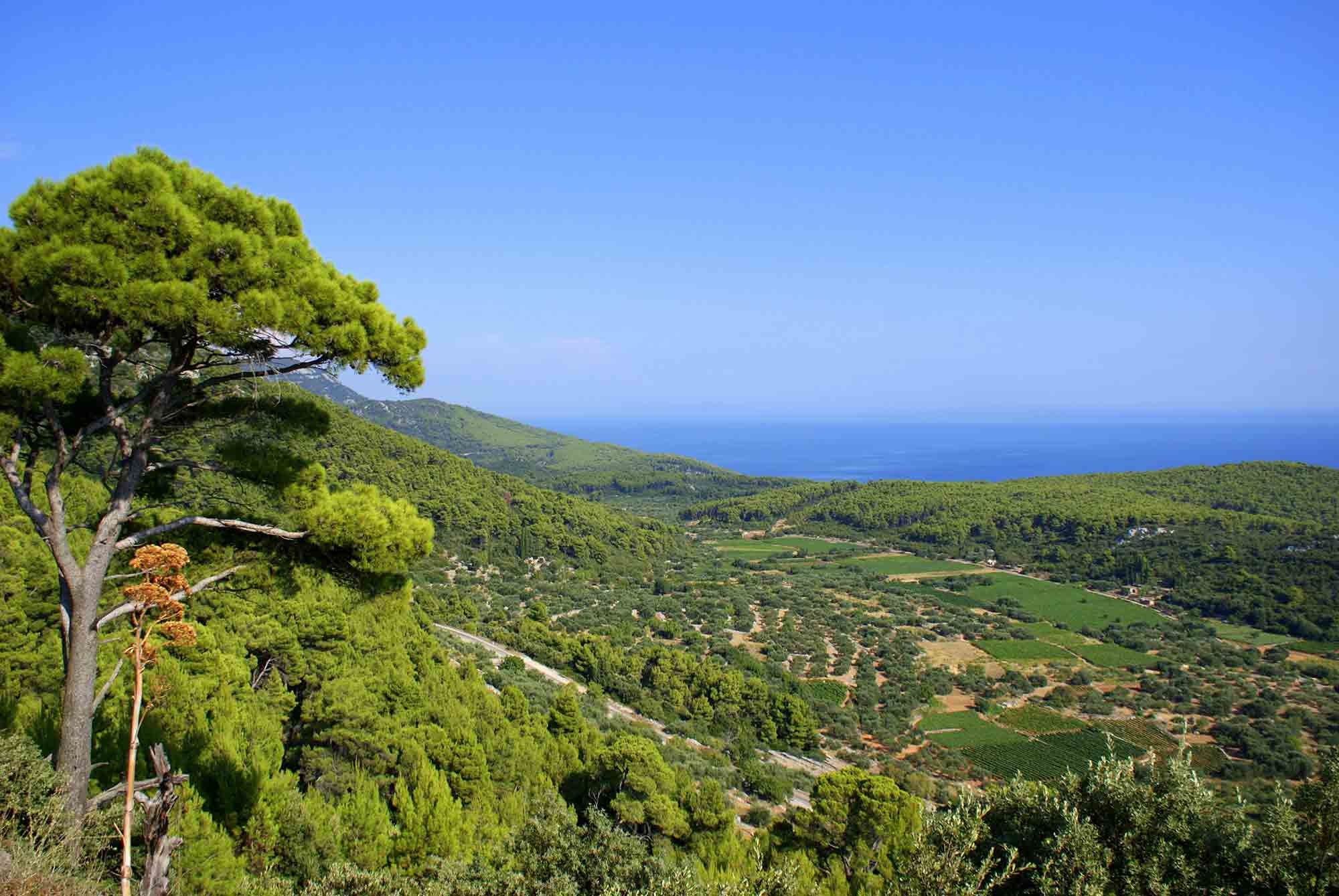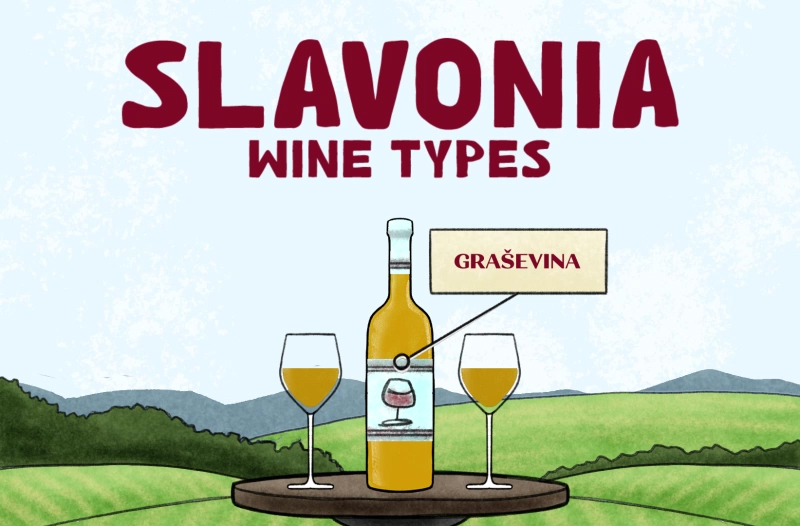Continental Wines vs. Mediterranean Wines
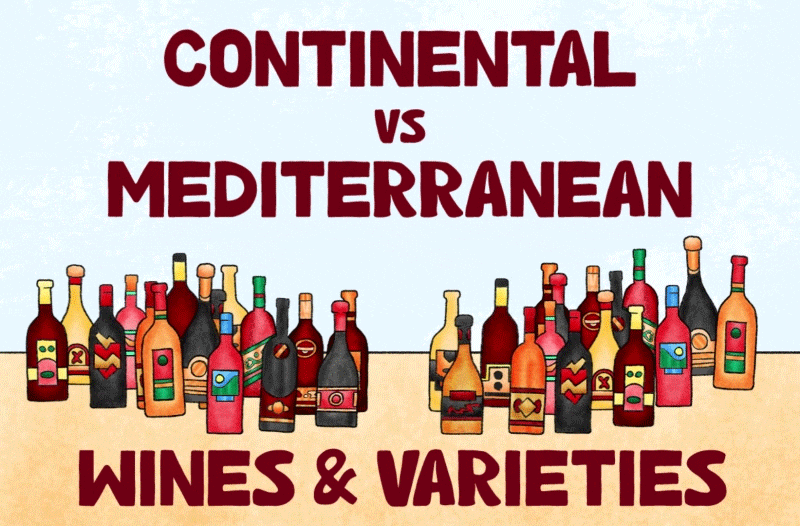
Climate influence on Mediterranean and continental wines
Before we talk about the wines, let’s first understand how climate affects winemaking, particularly the differences between continental and Mediterranean climates.
The ideal climate for growing grapes is typically found between the 30th and 50th parallels in both the Northern and Southern Hemispheres. Beyond these latitudes, conditions are often considered either too hot or too cold for successful grape cultivation.
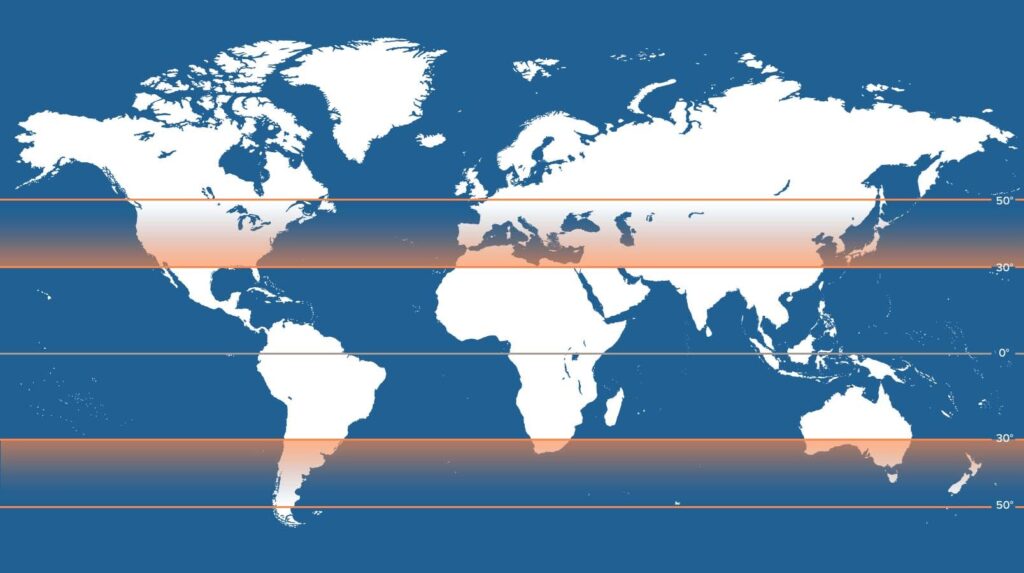
In viticulture, climate refers to the weather conditions throughout the grape’s growth cycle, from spring bud break to winter dormancy. The quality of grape growth and, consequently, wine production overall, are significantly influenced by weather patterns.
Climate, geography, and terroir are vital in deciding which grape varieties can flourish in a specific region or larger area, how fully they ripen, and in some cases, whether there are conditions for consistent grape quality every year.
The best climates for growing grapes can be grouped into three main categories:
- continental,
- maritime, and
- Mediterranean.
Each type affects grape growth differently.
The suitability of an area for wine production depends on how much of it is influenced by a specific climate. This is often categorized as:
- Macro-climate: referring to a larger wine region.
- Meso-climate: indicating the size of a vineyard.
- Microclimate: describing conditions for a particular row of vines.
Various microclimate conditions are becoming increasingly important as the wine industry responds to emerging global wine trends.
It can affect grape growth in various ways. For example, various factors like diurnal range, terroir, temperature, light, sun exposure, rainfall, altitude, inclination, and wind will influence grape growth.
Certain varieties may not thrive in specific areas due to unfavorable climate conditions.
There are also several other climatic factors to consider. For instance, the mentioned difference in temperature between day and night, known as the diurnal range, is important for wine production.
For certain grapes, a wider diurnal range is great because it means warm days ripen the grapes and intensify flavors, while cool nights help keep acidity and aromas fresh. Regions with a significant diurnal range often produce crisp and more aromatic wines.
In our journey through the world of wines, we’ve seen firsthand how weather can make or break a wine year.
Climate change over the last hundred years has pushed grapevines to adapt. Vines bud earlier in spring now than they used to. This means that in some regions grapes bloom sooner and are ready for harvest quicker.
Climate doesn’t just shape the taste of wine; it decides if there’s even wine to taste at all!
Terroir and climate influence on wine
Wine reflects a range of influences, encapsulated in the term “terroir,” which encompasses environmental and cultural factors involved in grape growing and winemaking.
Comparing climate to terroir in wine is akin to comparing broad weather patterns to the unique, signature fingerprint of a specific micro-location or a vineyard.
Terroir is specific to a location and can vary greatly, even within the same area.
For instance, two vineyards in the same subregion (even micro-location) might have different soil types, and microclimates, resulting in distinct terroir characteristics.
Terroir adds personality to a wine, shaping its characteristics and making it distinct. While climate sets the overall conditions for grape growth, terroir influences the finer nuances of the wine’s character.
Certain cult Croatian wines and signature wines serve as powerful “reflections” of the terroir where they originate.
Historically, the concept of terroir originated from the winemaking practices of the Cistercian monks in Burgundy.
Generally speaking, terroir includes weather, geology, soil, and their interactions, often associated with a sense of place or geographic identity and human impact.
Although there’s ongoing debate about terroir and its significance, it’s widely acknowledged that terroir, as well as climate, plays a crucial role in viticulture and wine production.
In short, climate determines which grape varieties thrive in certain regions, affecting their quality and yield. In viticulture and winemaking, climate is essential for ripening grapes adequately, influencing the style of wine produced.
Terroir adds a specific imprint to certain grape varieties that flourish in particular locations.
When it comes to comparing continental wines with Mediterranean ones, wine enthusiasts will likely notice distinct differences after a few tastings. Wines from cooler continental regions and warmer Mediterranean areas each have unique characteristics in both flavor and aroma.
Grape varieties thriving in cooler climates usually yield more delicate wines, with lower alcohol content, refreshing acidity, lighter body, and vivid fruit flavors. In contrast, those from warmer climates result in fuller-bodied wines, higher alcohol levels, milder acidity, and richer, riper fruit flavors.
Continental climate and wines by wine region
In reality, few regions are purely one climate type or another. One type predominates, but there may be influences of another, due to factors such as mountains or a distant body of water.
In a region with a continental climate, winters are usually colder, and summers are hotter, with a larger, quicker temperature drop in the fall.
Here are some examples of popular European continental wine regions with popular and predominant grape varieties.
| Popular European Wine Regions | Continental Climate Characteristics | Popular Grape Varieties |
|---|---|---|
| Burgenland, Austria | Continental Pannonian climate. Mild climate with an average of over 2000 sun hours per year. Unique microclimate due to Lake Neusiedl. | Pinot Blanc, Chardonnay, Grüner Veltliner, Neuberger, Blaufränkisch, St. Laurent, Zweigelt |
| Burgundy, France | Mostly continental, experiencing hot summers and cold winters, with hailstorms being a constant threat. Various microclimates influenced by factors like vineyard orientations, terrain, and prevailing winds significantly impact terroir expression. | Pinot Noir, Chardonnay, Aligoté, Gamay. |
| Champagne, France | The climate is continental with some maritime influence from the ocean/Atlantic. Winters can be freezing, while summers tend to be hot. | Chardonnay, Pinot Noir, Pinot Meunier, Pinot Blanc, Pinot Gris, Petit Meslier |
| Mosel, Germany | Northernly continental and maritime climates are marked by cool temperatures. The most productive vineyards are situated along the Mosel River, benefiting from the heat reflected from the water. | Riesling, Müller-Thurgau, Elbling, Kerner |
| Northern Rhone, France | Continental climate with harsh winters but warmer summers. Weather is greatly affected by the Mistral wind, which brings colder air from the Massif Central. | Syrah, Marsanne, Roussanne, Viognier |
| Rioja, Spain | The climate is primarily continental but also influenced by both the Mediterranean (in the eastern regions) and Atlantic climate (in the northwest). Hot summers, cold winters, and relatively high rainfall. | Tempranillo, Garnacha, Graciano, Malvasía, Garnacha Blanca, Tempranillo Blanco, Maturana Blanca, Turruntés, Verdejo |
| Sancerre, France | The Loire River divides the region into northern and southern climates and slightly raises temperatures. Rainfall occurs year-round. Western areas are influenced by the Atlantic Ocean, resulting in milder and wetter conditions. Eastern regions have a more continental climate, with drier, hotter summers, and colder winters. | Sauvignon Blanc |
| Slavonia and Danube region, Croatia | Mild continental climate, characterized by hot summers and relatively cold winters, with the rainfall equally distributed throughout the year. | Graševina (Welschriesling), Sauvignon Blanc, Riesling, Chardonnay, Pinot Noir, Blaufränkisch (Frankovka), Merlot, Cabernet Sauvignon, |
Mediterranean climate and wines by wine region
Mediterranean climate is typically temperate, featuring a prolonged, and dry growing season.
Temperatures remain relatively stable throughout the year, with winters typically milder compared to maritime and continental regions. The growing season is extended, accompanied by minimal rainfall.
Here are some examples of popular European Mediterranean wine regions with popular and predominant grape varieties.
| Popular European Wine Regions | Mediterranean Climate Characteristics | Popular Grape Varieties |
|---|---|---|
| Languedoc-Roussillon, France | The climate is typically Mediterranean, characterized by mild winters, dry summers, moderate springs and autumns. | Picpoul de Pinet, Syrah, Grenache, Carignan, Mourvedre, Grenache Blanc |
| Provence, France | Mediterranean climate with long, dry summers. Spring and fall storms bring significant rainfall. The Mediterranean Sea and the famous Mistral wind help regulate the temperature. | Mourvèdre, Syrah, Grenache, Cinsault |
| Tuscany, Italy | Dry, hot summers, warm springs, and mild, rainy autumns and winters. Altitude, exposure, and temperature fluctuations during the day all play a part in creating climatic conditions that balance the sugar, acidity, and aromas in wines. | Sangiovese. Merlot, Cabernet Sauvignon, Syrah, Cabernet Franc, Trebbiano, Vermentino, Vernaccia |
| Campania, Italy | Campania’s climate varies, Mediterranean on the coast, colder and rainier in the mountains, and slightly continental in the east. Summers are generally hot and sunny. | Falanghina, Fiano, Aglianico, and Greco |
| Jerez, Spain | Dry and scorching summers, with temperatures soaring. However, ocean breezes bring rain to the vineyards, while clay soils retain water beneath the surface. | Palomino, Pedro Ximenez, Moscatel |
| Sardinia, Italy | The summers are short, hot, humid, and arid. The winters are long, cold, windy, and partly cloudy. | Cannonau, Vermentino, Monica |
| Sicily, Italy | Mediterranean climate, with mild and wet winters, and dry and hot summers. | Grillo, Nero d’Avola., Catarratto, Carricante, Nerello Mascalese, and Frappato |
| Central, Southern, Crete, and the Aegean Islands, Greece | Mild Mediterranean climate with rainy winters except on the Aegean Islands where the arid Mediterranean climate dominates. | Assyrtiko, Agiorgitiko, Mavrodaphne, Moschofilero, Savatiano, Malagousia, Roditis, Robola, Vidiano, Liatiko, Kotsifali, Limnio, Mandilaria, Muscat of Somos |
| Dão, Douro, Portugal | Overall, the wine regions in mainland Portugal have Mediterranean-like climatic conditions, with warm dry summers and mild wet autumns and winters. | Touriga Nacional, Touriga Franca, Touriga Barocca, Bastardo, Tinto Cão, Bical, Cercial, Malvasia Fina, Rabo de Ovelha, Verdelho, Baga, Alfrocheiro, Jaen and Tinta Roriz |
| Istria and Kvarner, Dalmatia, Croatia | In Istria and the Kvarner region, the climate is more temperate. In Dalmatia, however, the Mediterranean climate dominates, with long, hot, dry summers and mild, short, wet winters. | Malvasia Istriana, Plavac Mali, Teran, Pošip, Grk, Debit, Maraština, Žlahtina, Babić |
Comparing wine styles: Continental vs Mediterranean
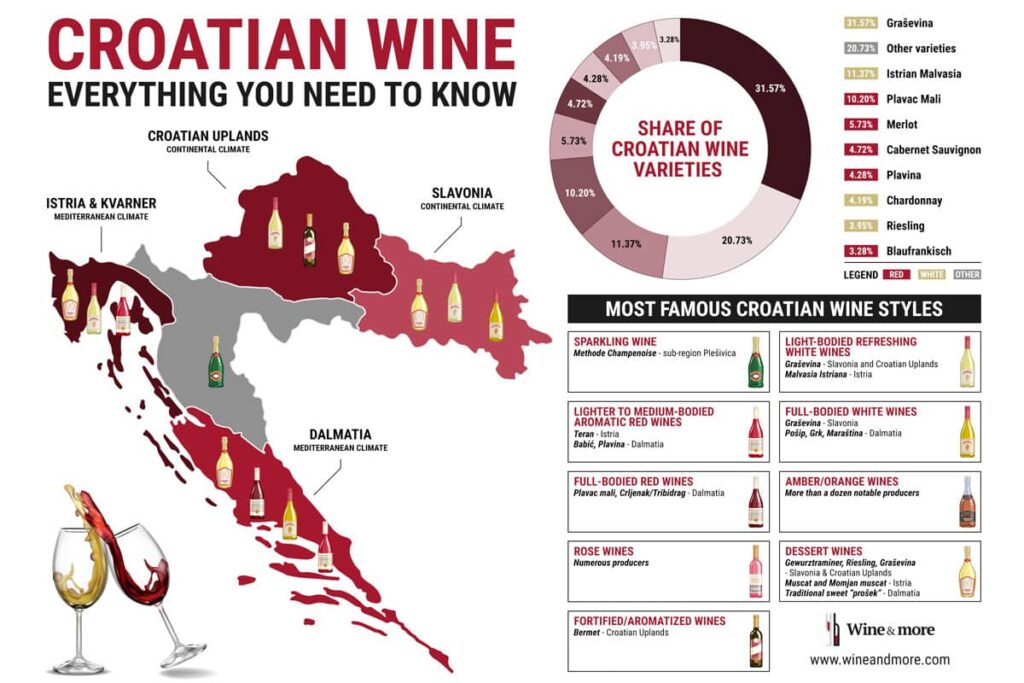
We’re delving into the core differences between continental wines and those from the Mediterranean, using Croatian wines as our focal point.
Croatia’s favorable geographic location, diverse climates, and pedological conditions have contributed to the production of some of the most exciting indigenous grape varieties.
There are four distinct Croatian wine regions you should be aware of when searching for the perfect drop.
- Istria and Kvarner: Located in the westernmost part of Croatia along the coastal tip. Its proximity to the coast provides a moderate Mediterranean climate with warm summers and mild winters.
- Dalmatia: Renowned as Croatia’s most diverse and picturesque wine region, its hot Mediterranean climate, varied topography, elevation, and climate, make it an ideal region for a wide range of authentic grape varieties.
- Slavonia and Danube: Marked by a moderate continental climate, with vast plains bordered by three rivers: the Danube, Drava, and Sava. As you venture deeper into Slavonia, the expansive plains transition into mountains, hills, and valleys adorned with charming vineyards.
- Croatian Uplands: Surrounds the capital city of Zagreb. This hilly area receives cool air from the nearby Alps in the north, making it ideal for producing sparkling wines.
Let’s lay out the facts, side by side, in a way that’s easy to grasp.
| Aspect | Continental Wines | Mediterranean Wines |
|---|---|---|
| Climate Conditions | Marked seasonal temperature changes, with hot summers and colder winters. | Warm, sunny, dry summers with mild winters and little seasonal change, allow for a longer growing season. |
| Impact on Wines | Tend to have higher acidity and more subtle fruit flavors due to the cooler overall climate. | Fuller-bodied with lower acidity, higher alcohol content, and ripe, more robust fruit flavors. |
| Popular Varieties | Graševina, Sauvignon Blanc, Blaufränkisch, Chardonnay, Pinot Noir, Merlot, Cabernet Sauvignon, Cabernet Franc | Plavac Mali, Pošip, Malvasia Istriana, Teran, Grk, Babić |
| Style | More structured, with a balance between fruit, acidity, and tannins. | Richer, more lush and hearty, often with a velvety texture and a generous dose of tannins. |
The contrasts in climate between the continental and Mediterranean wine regions craft wines that are as diverse as they are delightful.
Through understanding these differences, we arm ourselves with the knowledge to select wines that truly resonate with our palates and occasions.
So, next time you’re pondering over bottles, consider the climate. It might just lead you to your new favorite wine.
Croatian continental wines
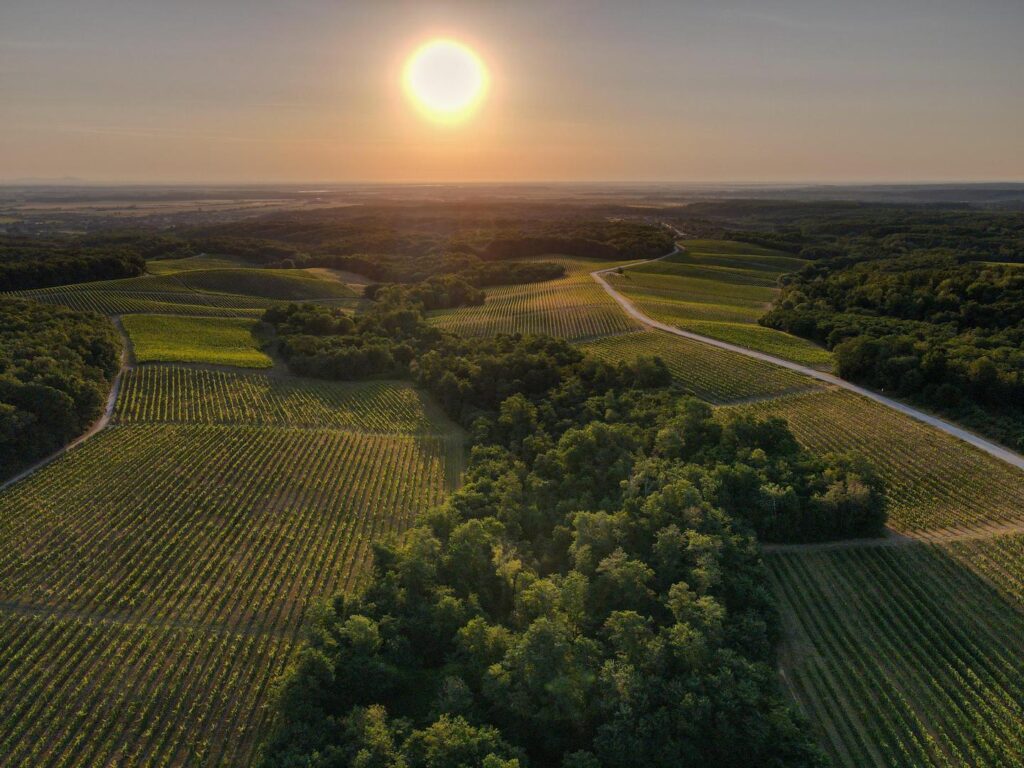
Continental climates are typical in regions far from large bodies of water, often shielded by nearby mountains.
Continental climates are generally found more inland. They have the greatest temperature difference between hot and cold months. Typically, a region with a continental climate experiences shorter to moderate hot summers, followed by a larger, rapid drop in temperature in the fall.
This climate is prevalent in the Northern Hemisphere, with renowned regions like Burgundy, Northern Rhone, Loire, Rioja, etc. A rare Southern Hemisphere example is found in Argentina’s Mendoza region.
In spring, these regions face the threat of frost during budbreak, along with shifting temperatures and changing weather patterns during the growing season. These factors can impact flowering, and overall ripening. Therefore, grapes that bud later in spring and ripen early in fall are most suitable for this climate.
Discovering Croatian continental wines in wine regions such as Slavonia and the Danube opens a door to less-known varieties, diverse wine types, and flavors.
In the spring, these region run the risk of frost during budbreak, followed by lower average temperatures throughout the growing season. Those lower temperatures can affect flowering, fruit set, and overall ripening. Therefore, grapes that have a later budbreak in the spring and ripen early in the fall are best suited to this climate.
Let’s step into the heart of Croatian continental winemaking to uncover some hidden gems and age-old traditions in wine production.
Popular varieties and styles
In addition to well-known international varieties like Pinot Gris, Chardonnay, Merlot, Cabernet Sauvignon, Cabernet Franc, Zweigelt, and others, we’ll explore some of the most popular (but less known internationally) varieties and styles from Croatian continental wine regions.
White continental wines and varieties:
- Graševina: The most widely planted grape variety in Croatia, cultivated and well-adapted in the continental part of the country. Some of the most awarded and best-scored Croatian white wines are made from Graševina. Generally, most Graševina wines are produced dry, with moderate alcohol levels, pleasing acidity, and delightful varietal aroma of peach and apple with a subtle tartness, a desirable characteristic of this grape variety. But you can find this grape variety produced in all the most important styles – from fresh young wines and sparkling wines, through aged, and macerated, to the most demanding late harvest and ice wines. Some of the finest examples come from Enosophia Winery. Choose their Graševina Trs No 5 for a dry, soft, rounded, fresh, and lively wine, or opt for Graševina Goveđa Glava, an elegant, rounded, lively single-vineyard wine with pronounced notes of stone and candied fruit.
- Zeleni Silvanac (Sylvaner): One of Central Europe’s oldest grape varieties with exact origins unknown. Also known as Sylvaner in Austria and France. It’s mainly grown in continental Croatia, particularly in the Orahovica wine-sub region. Wines made from this grape are usually lighter and dry in style, fresh, with noticeable acidity and a delicate aroma.
- Pušipel (Moslavac): This grape variety isn’t native to Croatia but is grown in the Croatian Upland region. It goes by various names: Pošipel or Pušipel, Šipon in Slovenia, Furmint in Hungary, and Mosler in Germany and Austria. It’s often produced as refreshing, light and lively wine, often with a slight unfermented sugar with moderate alcohol content and well-balanced acidity.
- Kraljevina: Native to the region around Zagreb, specifically the Prigorje sub-region, Kraljevina is known for its citrus and green apple notes in a light-bodied profile with refreshing acidity. Don’t miss out on trying sparkling wine made from this grape variety – it’s sure to impress!
- Škrlet: Originally from the Moslavina sub-region, Škrlet’s exact origins remain a mystery. Known for its vibrant acidity, Škrlet wines are typically crafted to be enjoyed when young, offering a fresh and crisp taste. However, there are exceptions to this rule, with some winemakers crafting wines that showcase the true depth and aging potential of Škrlet when handled by skilled winemakers.
Red continental wine and varieties:
- Frankovka (Blaufränkisch): Originally from Central Europe, this grape is known as Blaufränkisch in Austria and Germany, and as Kékfrankos in Hungary. It typically produces intensely ruby-red wines with refreshing fruity flavors and an average alcohol content of around 13%. These wines often have higher tannins, balanced by just enough acidity. Frankovka wines from Croatia come in a variety of styles, ranging from light and easy to more complex and structured. Enosophia is a standout winery that has always honored the tradition of cultivating and nurturing Frankovka. Enosophia produces wines from Frankovka grapes in several different styles, each aimed at showcasing the grape’s finest qualities: sparkling Today Rosé, two expressions of rosé wine, Matarouge, and Dika, and two expressions of red wine, one aged in stainless steel named Dika and the other in the wooden barrels named Lingua Franka.
- Portugizac (Blauer Portugieser): Isn’t native to Croatia but has a long history across the continental region. This light-colored red grape is favored for its soft tannins and fruity taste. It ripens early, often used to make a young wine similar to Beaujolais Nouveau, known for its fresh, fruity flavors and relatively low alcohol content. This type of wine is usually ready to drink 6-8 weeks after harvest, which typically occurs in late October. Most Portugizac is produced in the Croatian Uplands regions.
Croatian Mediterranean wines
We’re diving into the rich world of Croatian Mediterranean wines, a journey that promises many authentic flavors. This adventure will take us to vineyards of the Istria Kvarner and Dalmatia wine regions.
The Adriatic Sea coastline provides an ideal environment for grape growing.
About one-third of Croatia’s wine is red, mostly produced along this coastal stretch.
Stretching from Istria in the north to Dalmatia in the south, this coastal region benefits from a Mediterranean climate.
Long, hot, dry summers and mild, short, gentle winters create perfect conditions for wine production.
Dalmatia, the islands, and the coastline have an infinite variety of microclimates resulting in micro wine-growing areas where terroir is a crucially important factor. A wide range of indigenous grape varietals are grown here.
Let’s uncover some of the most popular ones.
Popular varieties and styles
Let’s showcase the popular varieties and styles from Croatian Mediterranean regions.
White Mediterranean wines and varieties:
- Malvasia Istriana: Originating from the Istria region and known for its versatility. You can find it produced in various wine styles ranging from youthful and fresh to more serious barrel-aged versions. Typically, it remains a dry wine with low acidity. While most Istrian Malvasia is enjoyed young, some producers are crafting more structured wines suitable for aging in cellars. With proper care, Malvasia can benefit from aging in oak or acacia barrels, and some are even aged in amphorae. Additionally, there’s a growing trend of macerated Malvasia wines.
- Pošip: Native to Korčula, thrives in Dalmatian vineyards, most top-quality Pošip wines are balanced, ranging from robust and age-worthy to lighter and more refreshing styles. Pošip yields wines with higher alcohol content and an oily texture, yet remains balanced with a distinct Mediterranean character when produced right.
- Grk: Originating from the sandy fields near Lumbarda on Korčula. Despite its scarcity, Grk has gained popularity due to its unique expression and ability to age gracefully. Known for its rich texture and herbal bitterness, Grk develops mineral undertones over time, making it a prized find for wine lovers worldwide.
- Vugava: also known as Bugava, thrives on the stony and sandy soils of Vis Island. This aromatic white variety, characterized by ripe fruit aromas and herbal undertones, is renowned for its full-bodied yet refreshing profile. With higher alcohol content, Vugava is considered one of Croatia’s top white wines.
- Maraština: Known as Rukatac in Southern Dalmatia and Malvasia del Chianti or Malvasia Bianca Lunga in Italy, thrives throughout Dalmatia. Maraština naturally produces fuller-bodied wines with a creamy texture, low alcohol content, and acidity, salty minerality, and nutty notes alongside fruity and herbal elements.
- Žlahtina: Native to Vrbnik on the northern Croatian island of Krk, where it originated and is primarily produced. Žlahtina wines are ideal for summer sipping, with refreshing flavors of pears and delicate floral undertones. While its name may be tricky to pronounce, it’s certainly easy to enjoy. Typically light in alcohol content, Žlahtina has a crisp texture, featuring a salty mineral quality with subtle hints of citrus, green apple, or vineyard peach.
- Debit: Debit grape variety yields a dry, fresh, and mineral wine with a higher acidity and aromatic richness. Despite not being typical of Dalmatia regarding acidity levels, the vineyards where Debit grows, located in the Šibenik and Skradin hinterland, contribute to its fresher profile due to lower night temperatures compared to coastal areas. Aged Debit wines offer more depth, and intensity, with their distinct acidity.
- Kujundžuša: Native to inland Dalmatia, particularly around the town of Imotski and its sandy vineyards. Typically dry, it presents a wine with refreshing acidity and light mineral and salty notes, complemented by subtle fruity flavors.
- Bogdanuša: Translating to “God-given,” Bogdanuša grapes thrive in the Hvar Island on Stari Grad plain, known as the oldest continuously cultivated vineyard in the world and one of the must-visit Croatian heritage sites under UNESCO protection. Traditionally, this wine was enjoyed during religious celebrations, hence its name. Modern Bogdanuša wines are usually produced as light-bodied, crisp, and lower in alcohol and acidity.
- Prč: Another indigenous wine variety from the island of Hvar, but relatively unknown due to small production. Often blended with other grapes because of its high yield and sugar content. Traditionally, it’s included as one of the grapes in traditional Dalmatian dessert wine – Prošek.
Red Mediterranean wines and varieties:
- Plavac Mali: Hailed as the unofficial Croatian red wine king, steeped in generations of cultural heritage. This grape variety ripens late and yields sparingly. Wines made from Plavac often offer a rich aromatic complexity, unfolding with each sip to reveal layers of dark fruits such as blackberries and plums, sometimes accented by notes of carobs, dried figs, or cherries. Top-quality Plavac Mali wines are known for their robust, full-bodied, and intense character.
- Tribidrag (or Crljenak): Originally known as Tribidrag or Crljenak (and Zinfandel) this variety has a fascinating history linked to its Croatian origins. Scientific research has revealed its ancestral ties to the Croatian indigenous variety Tribidrag. Its grapes, renowned for their rich and juicy characteristics, produce wines with a diverse range of flavors. The distinctive aroma profile includes lush notes of dark berries, black cherries, and sometimes a hint of peppery spice.
- Teran, in Italian called Terrano is a variety mostly found in Western Istria, a source of a drawn-out dispute between Croatia and Slovenia. In good positions it givesalmost purple wine of a fruity aroma that is easy to recognize, unusually high acidity and high tannins and not too high alcohol content: 12 – 13%. It’s usually enjoyed as a young wine, as the traditional wisdom is that it does not age too well. Teran, a robust red variety grown in soils rich with iron. It has fruity aromas that are perfectly complemented by earthy, mineral notes.
- Babić: Babić has a remarkable ability to retain acidity, resulting in more vibrant wines. Crafting the perfect bottle involves achieving a delicate balance between fullness and ripeness, highlighting the unique fruitiness of marasca cherry and a mineral elegance, complemented by spices and subtle earthy undertones.
- Dobričić: Dobričić is an ancient red wine grape variety from the island of Šolta and one of the re-emerging stars of Dalmatian wine scene. Recently, there has been much interest in the discovery that it, together with Crljenak, is one of the parents of Plavac Mali. Generally, few top-quality wines made from this variety are exceptionally harmonious with soft tannins and sweet aromas of plum and red fruits.
- Plavina: Also known as Plavka, used to be one of the most common red grape varieties in Dalmatia, right after Plavac Mali. It’s still quite popular in the region today. Unlike some other red grapes grown here, Plavina has a unique flavor profile. Wines made from Plavina grapes are known for their freshness, with alcohol levels ranging from lower to medium, and surprisingly mild tannins. This makes Plavina wines very easy to drink and enjoy.
- Lasina: Rare and ancient native grape variety from Dalmatia. It’s known for being challenging to grow due to its low yield, but the effort pays off with its intensely aromatic fruits of superb quality. Some people even call it the “Dalmatian Pinot Noir” because of its elegant and stylish character. When crafted by top producers, Lasina wine is elegant, complex, and fruity, with distinctive floral aromas.
Conclusion
The essence of continental versus Mediterranean wines lies in the climate and terroir.
Both continental and Mediterranean wines offer distinct pleasures reflective of their origins.
Viticulture thrives under varied climates making every bottle an exploration.
Each of the wines and varieties mentioned, tell a story about the place they come from—the climate they endure, the soil they grow in, and the people who make them into wine we love to drink.
We encourage you to explore beyond known labels – finding joy in discovering new wines and varieties that resonate with personal taste rather than sticking strictly to one type over another.
Finding your preference can be like uncovering treasures hidden within each region’s unique landscape.
Track down those bottles, enjoy them amidst good company, and most importantly let them speak stories born out of grapes nurtured under varying regions and climates.
We hope you find new favorites among these tastes and stories!
Cheers! 🍷🥂



